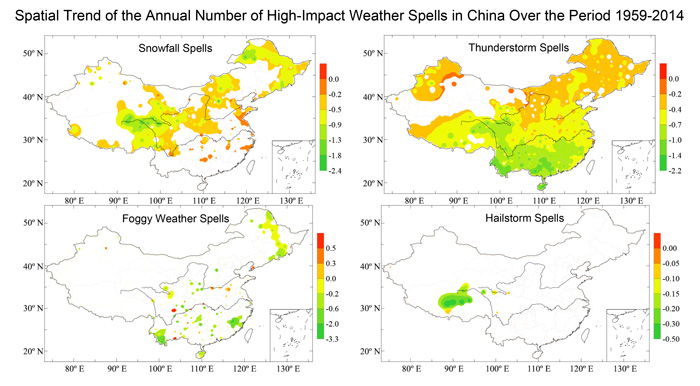| Follow @co2science |
Paper Reviewed
Shi, J., Wen, K. and Cui, L. 2016. Patterns and trends of high-impact weather in China during 1959-2014. Natural Hazards and Earth System Sciences 16: 855-869.
How have high-impact weather phenomena throughout one of the world's largest countries been impacted as the planet's air temperature has gradually risen over the period stretching from 1959 to 2014? Enquiring minds would surely like to know. So here's what three Chinese researchers have recently learned and subsequently written about the high-profile subject.
Focusing on four types of high-impact weather (HIW) phenomena, Shi et al. (2016) examined "distribution patterns and variation trends in the number of days and spells of four types of HIW, which is weather that can result in significant impacts on safety, property and/or socioeconomic activity (Sills, 2009), i.e. snowfall, thunderstorms, fog and hailstorms, based on the daily weather monitoring data of the whole of China during 1959-2014." And what did these efforts reveal?
The three Chinese scientists say that their results confirm "a significant decrease in the number of snowfall days, thunderstorm days and thunderstorm spells in all six regions of China," while further noting that "the number of foggy days, hailstorm days and snowfall spells decreased at rates of 0.2-1.8 days, 0.1-0.7 days and 0.14-0.44 times per decade respectively in almost all regions," while also noting that "fog and hailstorm spells decreased" -- but not significantly -- "at rates of 0.06-0.17 and 0.001-0.043 times per decade respectively in most regions of China."

Figure 1. Spatial trend of the annual number of high-impact weather spells in China over the period 1959-2014, including snowfall spells (top left), thunderstorm spells (top right), foggy weather spells (bottom left) and hailstorm spells (bottom right). Units are in the number of times per decade. Source: Shi et al. (2016).
And so it is that climate-alarmist claims of significant CO2-induced increases in high-impact weather events are about as far afield of reality as they could possibly be, especially in the case of China over the last half-century or so.
Reference
Sills, D.M. 2009. On the MSC forecasters forums and the future role of the human forecaster. Bulletin of the American Meteorology Society 90: 619-627.




